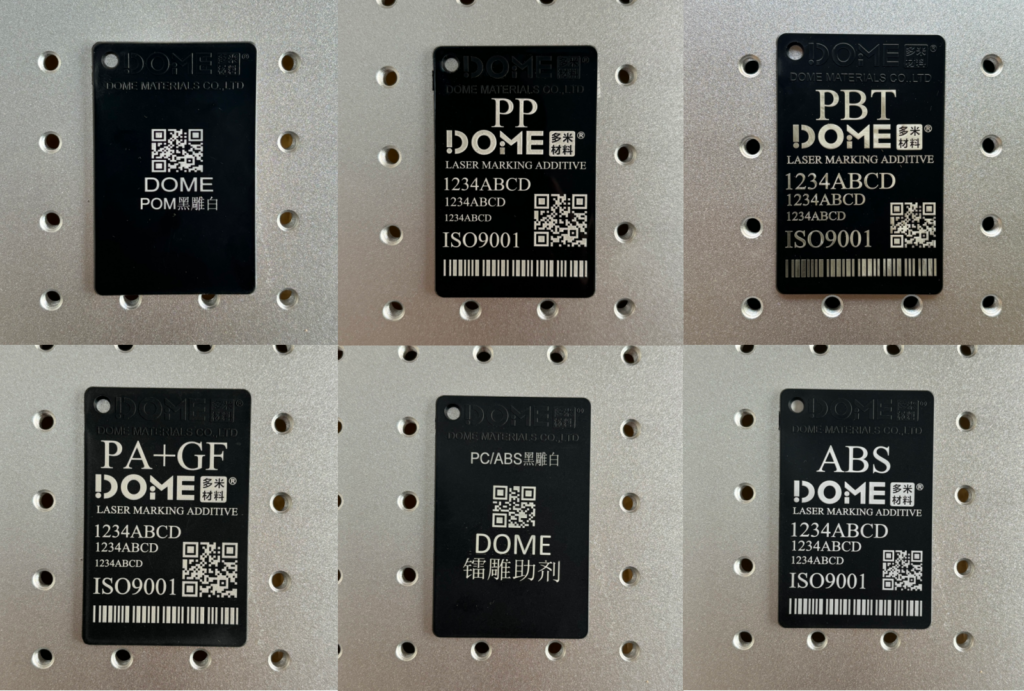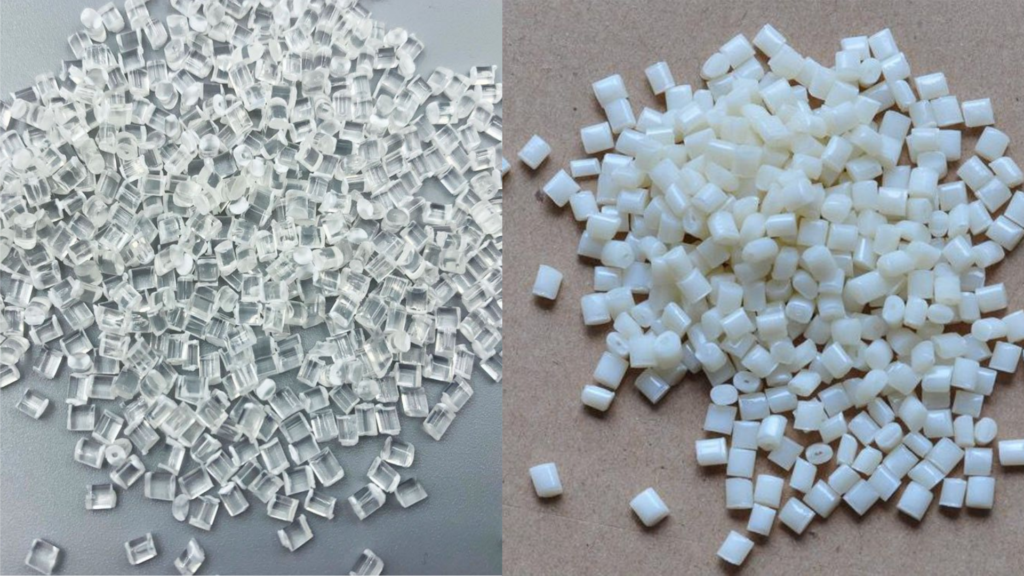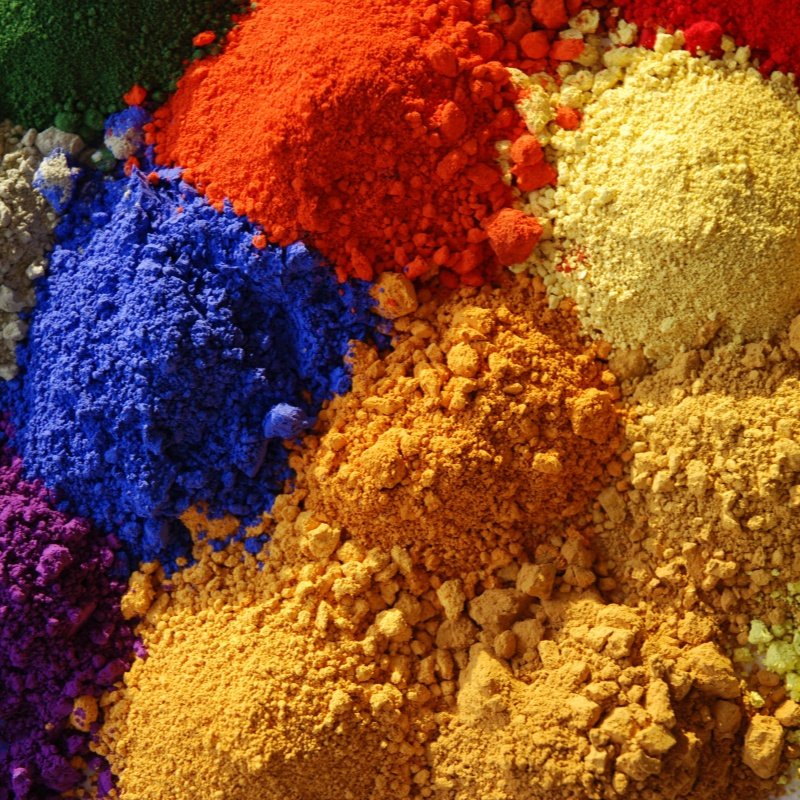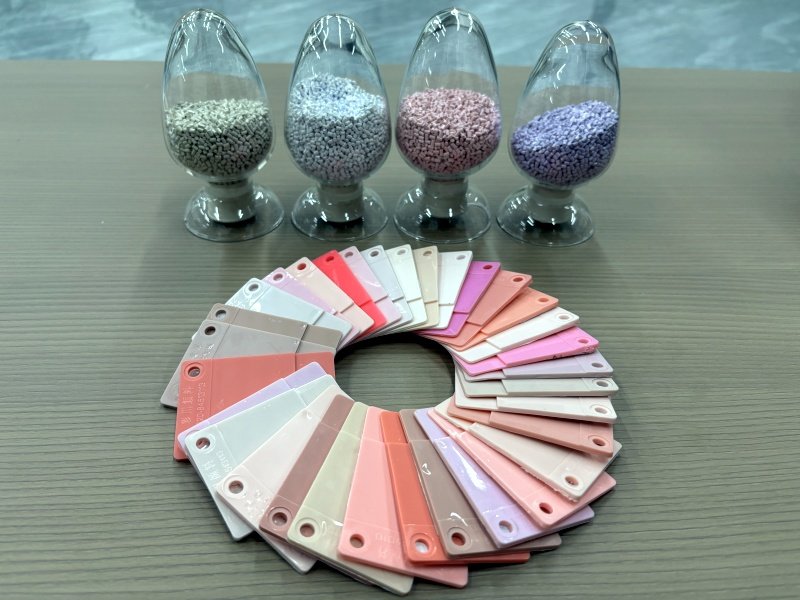Laser marking has become an indispensable technique in plastic manufacturing, offering a durable, precise, and aesthetically pleasing way to add logos, serial numbers, barcodes, or decorative patterns to plastic parts. When it comes to black molded thermoplastics such as ABS, PP, PA66, PC, PBT, and POM, achieving crisp, high-contrast white laser printing can be challenging due to the material properties and pigmentation. However, manufacturers can produce stunning results with the right approach, materials, and equipment. In this blog, we’ll explore four essential tips for success, focusing on the game-changing role of DOME Materials’ laser marking additives.

Tip 1: Start with Transparent or Natural Raw Materials
The foundation of successful laser marking lies in the choice of raw materials. Black molded plastics often contain carbon black or other dark pigments, which can interfere with the laser printing process. Carbon black, in particular, absorbs laser energy excessively, leading to inconsistent marking, burning, or poor contrast. To avoid these issues, it’s best to start with transparent or natural (unpigmented) raw materials for ABS, PP, PA66, PC, PBT, or POM.
Using transparent or natural resins allows the laser to interact more predictably with the material, creating cleaner and more defined white marks. When black coloration is required for the final part, manufacturers can achieve the desired aesthetic without compromising marking quality by incorporating laser-friendly additives and masterbatches, which we’ll discuss in the next tip. By avoiding heavily pigmented black resins, you set the stage for high-quality white laser marking that stands out against the dark background.

Tip 2: Enhance Contrast with DOME Materials’ Laser-sensitive Additives
One of the most effective ways to achieve crisp, white laser printing on black molded plastics is by incorporating DOME Materials’ laser additives into your formulation. These specialized additives are designed to optimize the laser marking process, delivering exceptional contrast, clarity, and durability. Unlike traditional black masterbatches or powders, which can dull or disrupt laser marking, DOME Materials’ additives are engineered to enhance the interaction between the laser and the plastic substrate.
DOME Materials offers a range of laser-activated additives and masterbatches tailored for thermoplastics like ABS, PP, PA66, PC, PBT, and POM. These additives work by increasing the material’s sensitivity to laser energy, allowing for faster marking speeds and sharper white marks. By replacing conventional black masterbatches with DOME Materials’ laser marking masterbatch, manufacturers can achieve a deep, uniform black color for the part while ensuring that the laser can create high-contrast white markings without burning or charring the surface.
The benefits of DOME Materials’ additives are numerous. They improve marking precision, reduce processing times, and enhance the overall appearance of the marked parts. Additionally, these additives are formulated to maintain the mechanical and thermal properties of the base polymer, ensuring that the final product meets performance requirements. Whether you’re marking intricate designs or simple text, DOME Materials’ laser marking solutions provide a reliable and efficient way to achieve professional-grade results.
Tip 3: Choose the Right Laser Type for Superior Performance
The type of laser used plays a critical role in the quality and durability of the markings. While UV lasers are sometimes used for marking plastics, they can be less effective for black molded thermoplastics due to their lower power and higher costs. A Fiber Laser is generally the better choice for white laser marking on ABS, PP, PA66, PC, PBT, and POM black molded parts. Fiber lasers offer several advantages, including higher energy output, better scratch and wear resistance, and lower operating costs.
Fiber lasers operate at a wavelength that interacts effectively with the molecular structure of thermoplastics, producing clean, white marks through processes like foaming or carbonization. Combined with DOME Materials’ laser marking additives, fiber lasers can achieve exceptional contrast and detail, even on complex geometries. The durability of fiber laser markings is particularly important for applications where parts are exposed to abrasion, chemicals, or environmental stress, such as in automotive, electronics, or medical device manufacturing.
Moreover, fiber lasers are more cost-effective than UV lasers, both in terms of initial investment and long-term maintenance. Their efficiency and versatility make them ideal for high-volume production environments where speed and reliability are paramount. By pairing a fiber laser with DOME Materials’ additives, manufacturers can maximize marking quality while keeping costs in check.
Tip 4: Fine-Tune Laser Parameters with Times Small-Area Tests
Even with the right materials and equipment, achieving perfect laser marking requires careful optimization of laser parameters. Factors such as power, speed, frequency, and focus distance must be adjusted to suit the specific plastic and additive combination. To ensure the best results, always conduct small-area tests before marking production parts.
Start by selecting a small, inconspicuous area of the part and run a series of test marks with varying laser settings. For example, adjust the power output to find the sweet spot where the laser produces a bright white mark without causing surface damage. Similarly, experiment with marking speed to balance quality and efficiency. Frequency settings can also influence the texture and contrast of the mark, so test different frequencies to achieve the desired effect.
When using DOME Materials’ laser marking additives, you may find that the material responds more readily to certain parameter ranges, allowing for faster and more precise tuning. Keep detailed records of your test results, including the settings used and the visual outcome, to create a reliable reference for future production runs. This iterative approach ensures that your laser marking process is optimized for consistency and quality across all parts.
Why DOME Materials’ Laser Marking Additives Stand Out
Throughout this blog, we’ve emphasized the transformative impact of DOME Materials’ laser marking additives. These products are specifically designed to address the challenges of marking black molded plastics, offering a level of performance that sets them apart from traditional solutions. Here’s why DOME Materials should be your go-to choice:
- Enhanced Contrast and Clarity: DOME Materials’ additives enable bright, white markings that pop against black backgrounds, ensuring legibility and aesthetic appeal.
- Compatibility with Multiple Polymers: Whether you’re working with ABS, PP, PA66, PC, PBT, or POM, DOME Materials offers additives and masterbatches optimized for each material.
- Improved Processing Efficiency: By increasing laser sensitivity, these additives allow for faster marking speeds, reducing production time and costs.
- Durability and Stability: The additives maintain the integrity of the plastic, ensuring that marked parts withstand wear, chemicals, and environmental exposure.
- Customizable Solutions: DOME Materials provides tailored formulations to meet specific application needs, from intricate designs to high-volume production.
By integrating DOME Materials’ laser marking additives into your process, you’re not just improving marking quality—you’re investing in a solution that enhances overall manufacturing efficiency and product value.
Conclusion
Achieving crisp, white laser marking on black molded ABS, PP, PA66, PC, PBT, or POM parts is a complex but rewarding endeavor. By starting with transparent or natural raw materials, incorporating DOME Materials’ laser marking additives, choosing a fiber laser, and fine-tuning your parameters, you can produce markings that are both visually striking and highly durable. Among these strategies, DOME Materials’ additives stand out as a critical enabler, offering unmatched contrast, efficiency, and versatility. Whether you’re manufacturing automotive components, consumer electronics, or medical devices, these tips, paired with DOME Materials’ innovative solutions, will help your parts shine with professional-grade laser markings.
For more information on DOME Materials’ laser marking additives and masterbatches, visit their website or contact their team to discuss your specific needs. With the right tools and expertise, your laser marking process can reach new heights of precision and performance.





